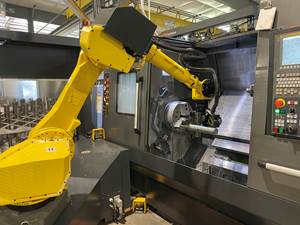Who’s Your CTO?
Every manufacturing company needs a leader to promote technological progress.
Share





In many discussions of corporate management structures, you will find the new title of chief technology officer (CTO) appearing. The CTO is usually an executive-level position tasked with addressing technological issues within an organization. Big corporations seem to be more likely to have a CTO than small- or medium-sized companies. However, all manufacturing companies ought to have a CTO, or at least a person designated to play this role.
Because manufacturing technology is currently undergoing a period of rather rapid and profound change, companies of all sizes should consider establishing this role (and perhaps giving it the title) of CTO. This role is important because manufacturers must plan for and carefully manage the adoption of new technology. To be clear, this adoption is not an option. Companies that don’t keep up with new ways to move work through the shop, new ways to motivate workers and improve their skills, new ways to please customers and so on, will lose out in the marketplace. They will be forced to close. Here is my thinking on the duties of a CTO.
Provide direction. A CTO may say, “We need to move to data-driven manufacturing,” or “The tool crib, the CNC programming department and the quality control staff must share data to learn from one another.” The CTO points to broadly defined goals to be reached with new systems, equipment, hardware, software or change to the infrastructure. The CTO draws from and adds to the insights of others involved in shopfloor management, marketing and sales, accounting and human resources, and, of course, the information technology (IT) staff. The CTO is always part of a team.
Set priorities. One important duty of the CTO is to create a technology roadmap. This is a plan with specific steps and a timeline. “Our first step toward data-driven manufacturing is machine monitoring for OEE (this year), integrating it with the job scheduling system (next year), then predictive maintenance (third year).” A good CTO can balance big-picture thinking with detailed planning.
Guide implementation. To follow this roadmap and reach company goals, the CTO takes the lead in procuring the technology solutions called for and seeing that they are put in place. Delegating responsibilities and coordinating activities wisely is essential. For example, if a machine-monitoring system is in the plan, installing new network cables might go to the maintenance crew or a contractor, while the IT department sets network routers and switches to protect its security. Conducting pilot programs and creating a training schedule might also be in a CTO’s jurisdiction.
Invent appropriate technology. The best CTO might also play a role in the development, or even the invention, of new technology for the company. Having software customized for a shop’s unique application is an example. One CTO I know is adept at creating apps for mobile devices used in his company’s production facilities. Participating in relevant standards-making initiatives as a member of a technical advisory group is another way a CTO might move technology forward, not only for the company, but also for the industry.
Having a CTO signals that a proactive approach to technology is a prime principle for the manufacturing company, both in outlook and practice.
Related Content
DN Solutions Responds to Labor Shortages, Reshoring, the Automotive Industry and More
At its first in-person DIMF since 2019, DN Solutions showcased a range of new technologies, from automation to machine tools to software. President WJ Kim explains how these products are responses to changes within the company and the manufacturing industry as a whole.
Read MoreSame Headcount, Double the Sales: Successful Job Shop Automation
Doubling sales requires more than just robots. Pro Products’ staff works in tandem with robots, performing inspection and other value-added activities.
Read MoreThe Power of Practical Demonstrations and Projects
Practical work has served Bridgerland Technical College both in preparing its current students for manufacturing jobs and in appealing to new generations of potential machinists.
Read MoreIn Moldmaking, Mantle Process Addresses Lead Time and Talent Pool
A new process delivered through what looks like a standard machining center promises to streamline machining of injection mold cores and cavities and even answer the declining availability of toolmakers.
Read MoreRead Next
AMRs Are Moving Into Manufacturing: 4 Considerations for Implementation
AMRs can provide a flexible, easy-to-use automation platform so long as manufacturers choose a suitable task and prepare their facilities.
Read MoreMachine Shop MBA
Making Chips and 91±¬ÁĎÍř are teaming up for a new podcast series called Machine Shop MBA—designed to help manufacturers measure their success against the industry’s best. Through the lens of the 91±¬ÁĎÍř benchmarking program, the series explores the KPIs that set high-performing shops apart, from machine utilization and first-pass yield to employee engagement and revenue per employee.
Read More



















